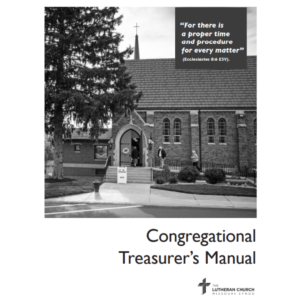After hearing a wide range of beliefs about dedicated funds and the treasurer’s manual, I realized there was no agreement among my fellow church members. I decided to call the local Lutheran Church Missouri Synod District Office. I was able to talk with Marilyn Allen, Business Manager, who is the resource person regarding the Treasurer’s manual. She graciously, and with great knowledge, answered all my questions. Now, I want to share with you the results of our conversation.
First, we must follow the Lutheran Church Missouri Synod Treasurer’s Manual. It instructs us on how to follow the rules for 501C3 Non-profit organizations (which we are) as legislated by the Federal government. It also instructs us on when we need to go to the state government. Then we get to follow state rules for non-profit organizations.
Second, when an individual donates to the church for a certain purpose, those funds are dedicated to that purpose in perpetuity (i.e.: forever). We can release those funds for other purposes only through one of the following ways:
perpetuity (i.e.: forever). We can release those funds for other purposes only through one of the following ways:
- We go back to the donor and ask them for their permission to re-allocate the funds. If the donor is deceased, we have an option of one of the two following:
- We go to the heirs and ask their permission to re-allocate the funds. This can be quite difficult because there often are many people to work with.
- The other option is to petition the state’s Attorney General for their permission to re-allocate the funds. Yes, there are processes and procedures we would have to follow. (It’s not a simple case of “Mother may I?’, “Yes you may.”)
The only time the funds can easily be re-allocated is if it is specified by the donor at the time of donation. Marilyn gave the following example: If a donor gave a donation to paint the church walls purple and stated that if they are not painted purple in 10 years, then the money can be re-allocated. (I don’t know about you, but I’d be waiting with bated breath for those 10 years to expire!)
She reminded me that Board (Council) designated funds are not restricted. An example of this is if the board allocated $4000 for materials to reside the Senior Center. Say materials cost $2500. At the end of the project, Council could then redesignate the remaining $1500 to General Fund to meet other financial obligations.
She also cautioned us that when we are raising funds (such as in a stewardship drive) that we do not be too specific. Her example was: The church has a fundraiser for new choir robes. If we raise $1000, but spend only $500, the remaining $500 will need to stay in a dedicated fund until the next time we need choir robes. She said it would be better to be more general and ask for funds for the Choir Department. That way the excess $500 can go to meeting other expenses in the department.
She also told me that many non-profits have an established policy that governs the terms under which they can accept a donation. It’s something to consider as/when we start looking at long-range planning for this church.
Next month I will share with you what I have learned about the funds we have invested with Edward Jones.
